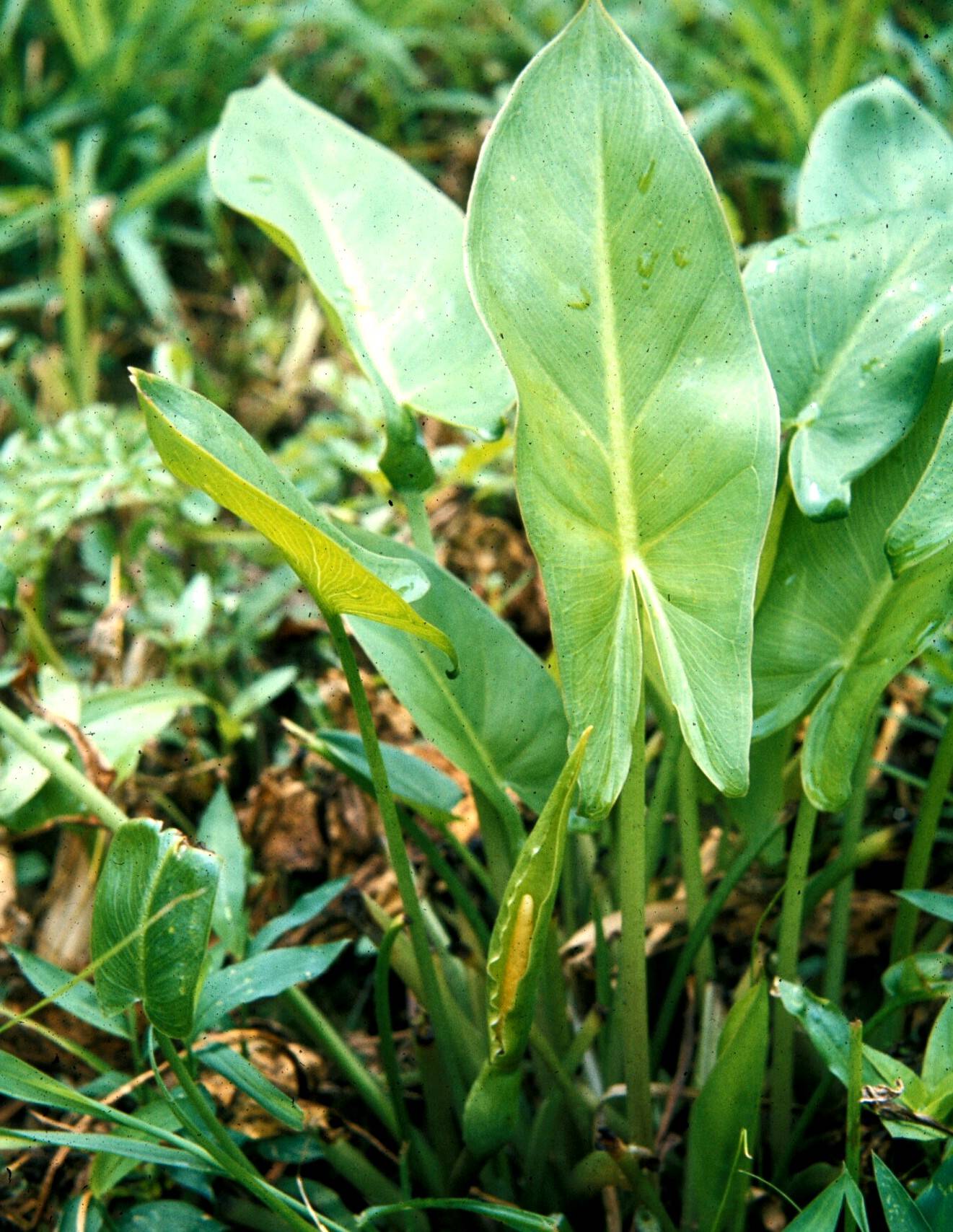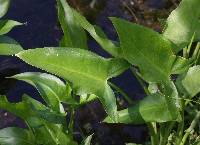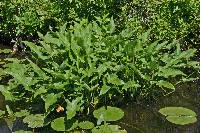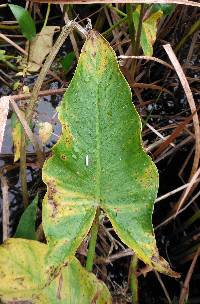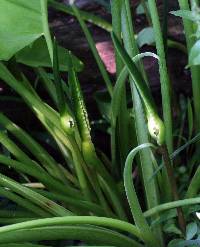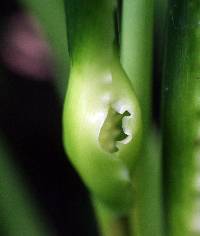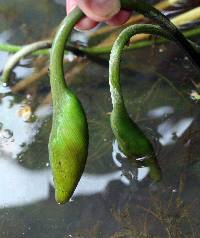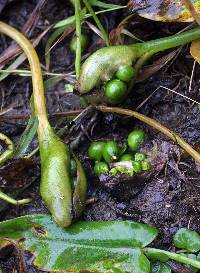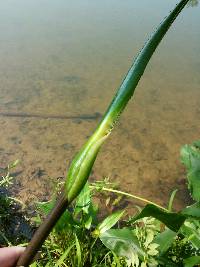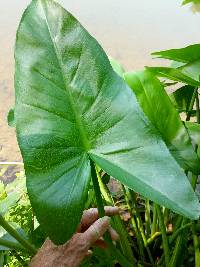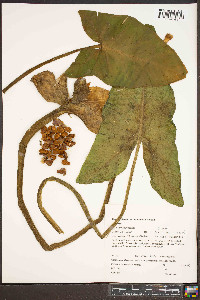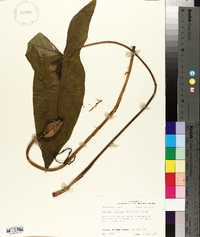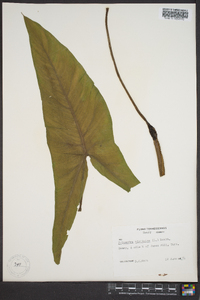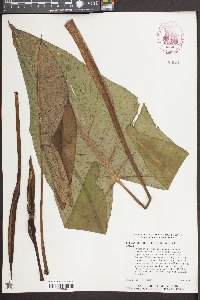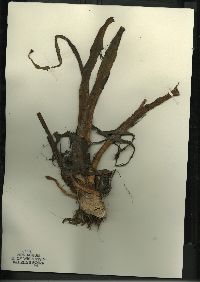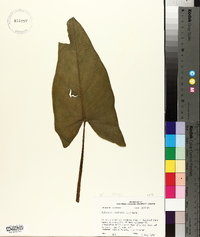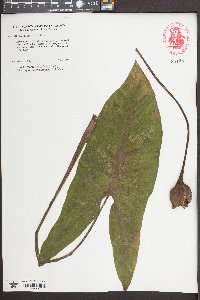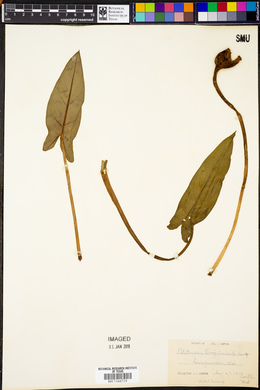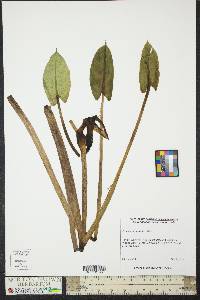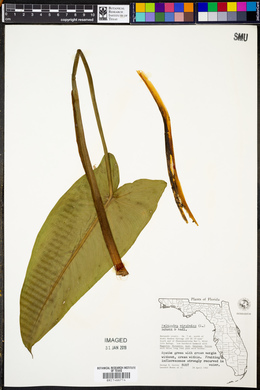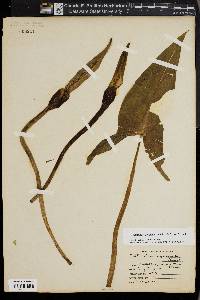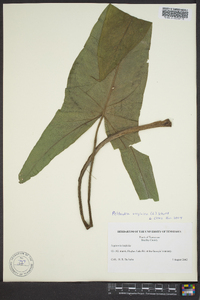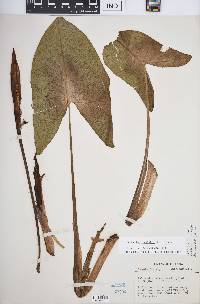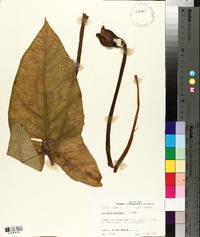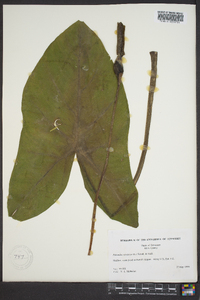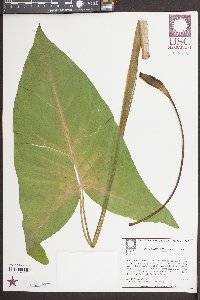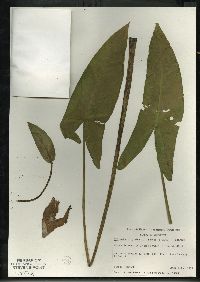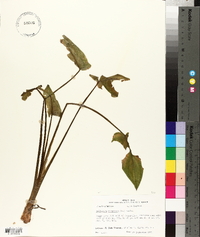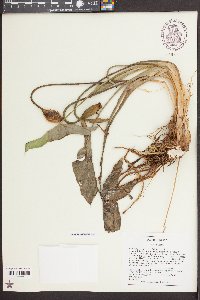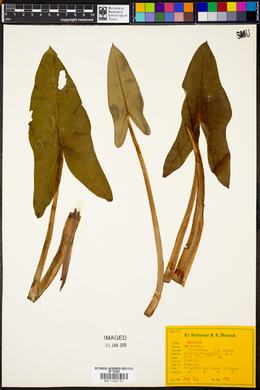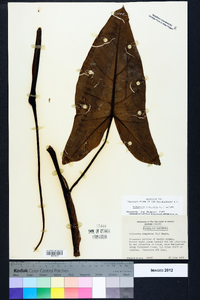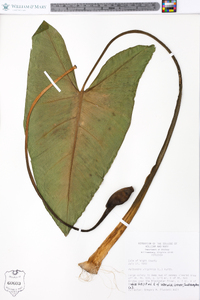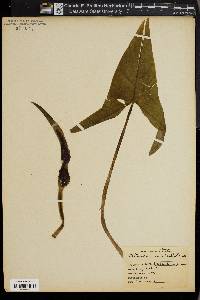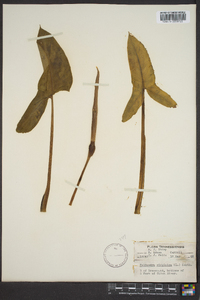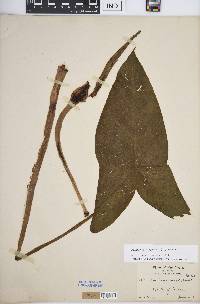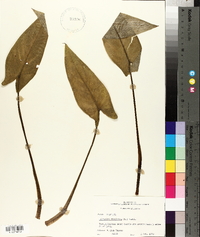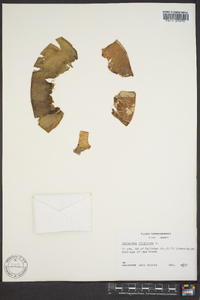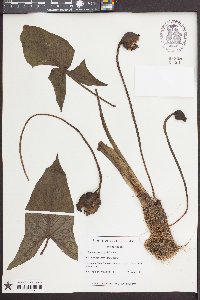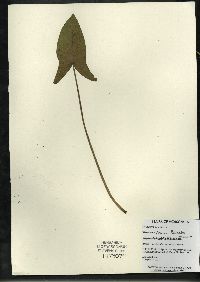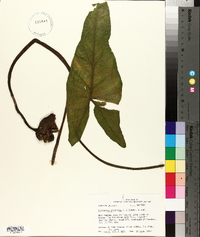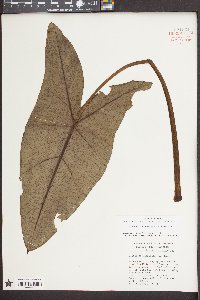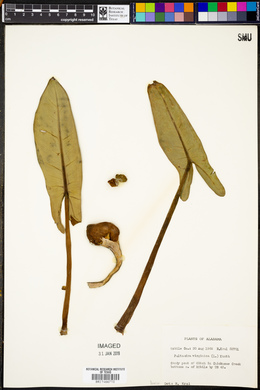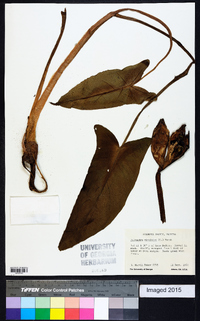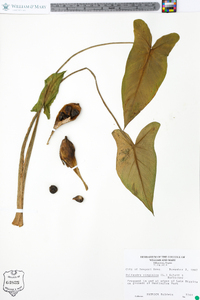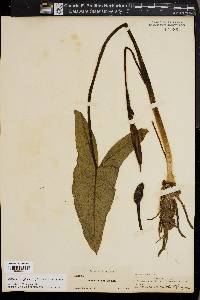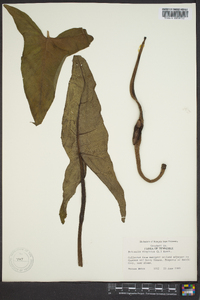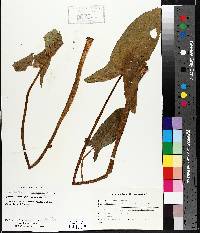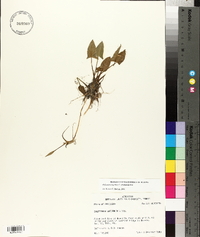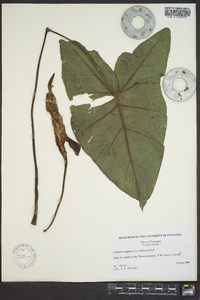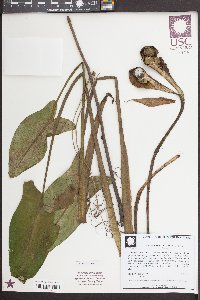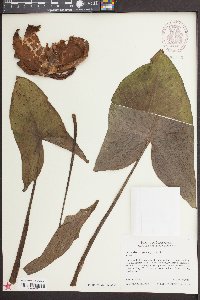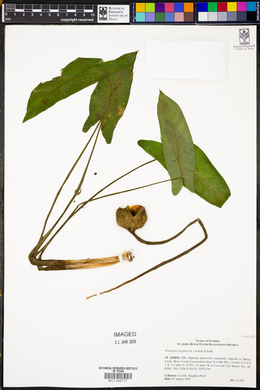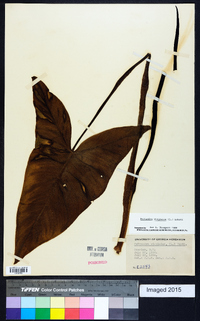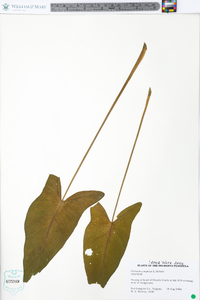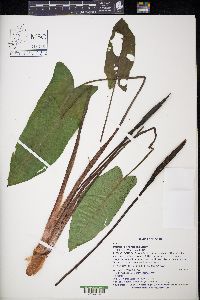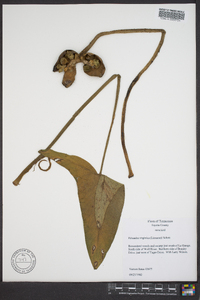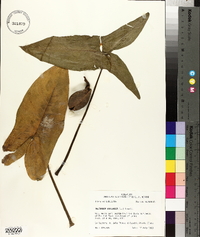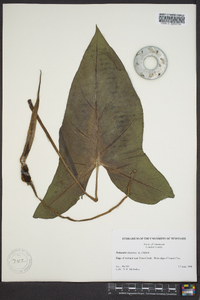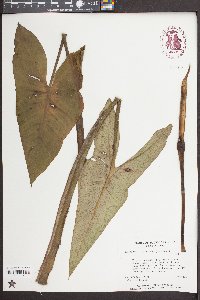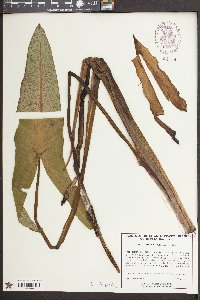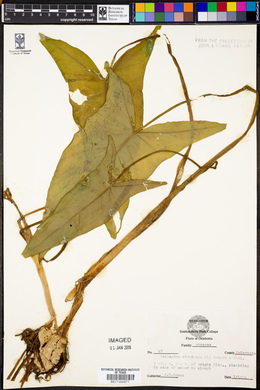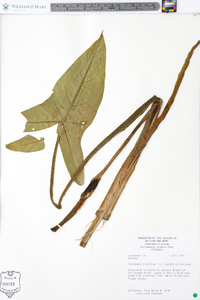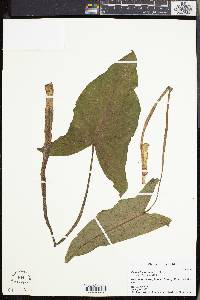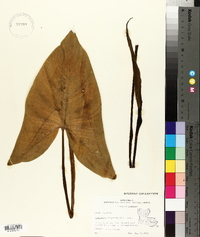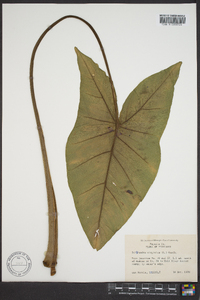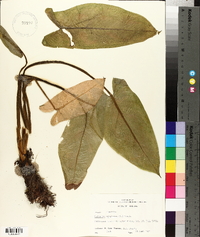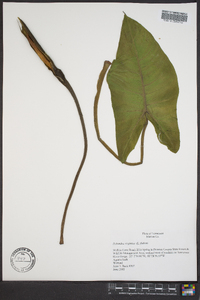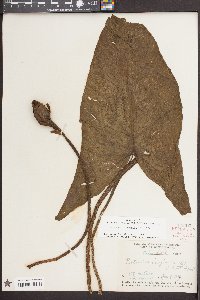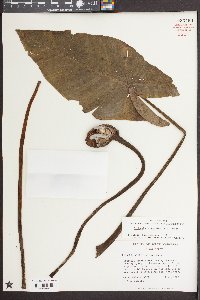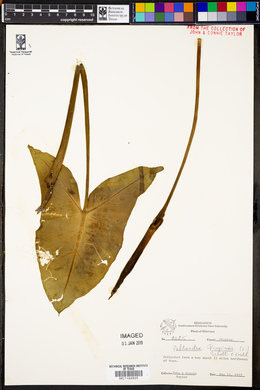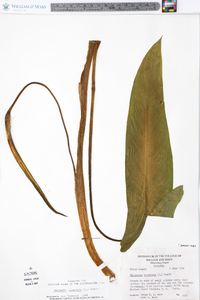Peltandra virginica
|
|
|
|
Family: Araceae
Green Arrow-Arum
[Peltandra undulata Raf., morePeltandra virginica f. hastifolia S.F.Blake, Peltandra virginica f. rotundata S.F.Blake] |
Leaves: petiole green to purple-green, 38--98 cm; blade medium green, not glaucous or slightly glaucous abaxially, 9--57 ´ (2.5--)5--15(--31) cm, larger on average and more variable in shape than in Peltandra sagittifolia; lateral veins of 2 thicknesses. Inflorescences 7--25 cm; peduncle 20--56 cm; spathe tube green outside, paler green within, closed; 1.5--3.5(--5.2) ´ 0.7--1.9 cm; spathe blade green to green with white or yellow-green along margins, loosening only to slightly open to fully open at anthesis, (5.9--)8.5--21.4 ´ 0.5--2.3 cm, margins undulate; spadix tapering apically, more than 1/2 to almost as long as spathe. Flowers: pistillate flowers pale green to greenish white, ovaries 1-locular; ovules 1--4; staminate portion of spadix white, cream white, or pale yellow; sterile flowers between pistillate and staminate flowers; sterile tip 0.5--2 cm. Infructescences enclosed by spathe tube, rotting away to release fruits. Fruits pea green to mottled green or very dark purple-green, 10--18 ´ 6--16 mm. Seeds 1--2(--4), embedded in mucilage, 8--17 mm. 2n = 112. Flowering spring--late summer, also fall and winter in the extreme southern areas of its range. Wetland habitats, including bogs, swamps, freshwater to low-salinity tidal marshes, and ditches, as well as along the edges of ponds, lakes, and rivers; 0--1200 m; Ont., Que.; Ala., Ark., Conn., Del., D.C., Fla., Ga., Ill., Ind., Iowa, Kans., Ky., La., Maine, Md., Mass., Mich., Minn., Miss., Mo., N.H., N.J., N.Y., N.C., Ohio, Okla., Pa., R.I., S.C., Tenn., Tex., Vt., Va., W.Va., Wis. Leaf shape is highly variable in Peltandra virginica, and different forms have been recognized taxonomically, both at the specific and infraspecific levels. Since Because leaf shape varies within populations and even within an individual clump of plants, P. virginica is treated here as a single taxon. Populations of Peltandra virginica are most common along the Atlantic Coastal Plain, but its range appears to be actively expanding. Since 1978, the species was reported as new to the floras of Iowa, Kansas, Minnesota, West Virginia, and Wisconsin, and introduced populations may persist in Oregon and California. Fruits and seeds of P. virginica are a food for wildlife, especially waterfowl, and their use by migratory birds is an important factor in the spread of this species. The flowers of Peltandra virginica are pollinated by a chloropid fly, Elachiptera formosa (Diptera: Chloropidae), which uses the inflorescence as a mating site and a larval food source. Eggs are deposited within the inflorescence, and the emerging larvae feed on the rotting male portion of the spadix. The fruits are primarily dispersed by water, although animals also play a role. Peltandra virginica may have been an important food plant for eastern Native Americans, especially in the mid-Atlantic coastal region from Pennsylvania to Virginia, where the plants are now common and grow in large, dense populations. Historical accounts mention use of the rhizomes as well as the leaves, fruits, and seeds as food.
Perennial herb 20 - 40 cm tall Leaves: basal, with a green to purplish green stalk 38 cm - 1 m long, 9 cm - 0.57 m long, 5 - 15 cm wide, arrowhead-shaped with short-pointed to rounded basl lobes, sometimes slightly covered with a whitish waxy coating (glaucous) beneath. There are three prominent veins on each leaf, with one vein running to the leaf tip and one running to the end of each basl lobe. Inflorescence: of many tiny flowers borne tightly clustered along a spike with a very fleshy axis (spadix), with male flowers above female flowers. The spadix is almost as long as the spathe, cylindric but tapering at the tip, and surrounded by a green leaf-like sheath (spathe). Spathe sometimes with a pale margin and a paler inner surface, 8 - 20 cm long, 0.5 - 2.3 cm wide, rolled up longitudinally, enclosing the female flowers but opening somewhat near the tip to expose the male flowers. Fruit: a cluster of green to mottled green or dark purplish green berries, each berry 6 - 16 cm wide, containing one to three seeds 8 - 17 mm long and surrounded by gelatinous material. The flower stalk recurves and the spathe collapses and becomes slimy, releasing the fruit. Similar species: Calla palustris, Peltandra virginica, Symplocarpus foetidus all have simple leaves and flowers covering most or all of the spadix. Calla palustris has a white spathe and small leaf blades (to 15 cm long) with heart-shaped bases. Symplocarpus foetidus has a green to purplish (often spotted or striped) spathe and large oblong to egg-shaped leaves (to 0.6 m long). Flowering: early June to mid July Habitat and ecology: Shaded swamps, shallow water, and acid bog depressions. Occurence in the Chicago region: native Etymology: Peltandra comes from the Greek words pelta, meaning shield, and aner, meaning stamen, referring to the fused and flat-topped stamens of the male flowers. Virginica means "from Virginia." Author: The Morton Arboretum Lvs oblong to broadly triangular, 1-3 dm at anthesis, larger later, a strong nerve descending into each of the divergent or parallel, acute to rounded basal lobes; scape 2-4 dm, recurved in fr; spathe green with pale margin, 1-2 dm, the part above the pistillate fls deliquescent in age, the lower part enclosing the fr; spadix nearly as long as the spathe, white to orange, the lower fifth pistillate; fr a head of brown berries, the 1-3 seeds surrounded by gelatinous material; 2n=88, 112. Swamps and shallow water; s. Me. to Fla., w. to Mich., Mo., and Tex. Late spring. (P. luteospadix) Gleason, Henry A. & Cronquist, Arthur J. 1991. Manual of vascular plants of northeastern United States and adjacent Canada. lxxv + 910 pp. ©The New York Botanical Garden. All rights reserved. Used by permission. From Flora of Indiana (1940) by Charles C. Deam In shallow water or in wet, mucky soil on the borders of lakes and ponds and along streams. Rather frequent in the lake area but rare to absent south of this area. The leaf blades of this species are highly variable, and a wide variation can be noted between the inner and outer leaves of the same plant. Besides the typical form, Blake (Rhodora 14: 102-106. 1 pl. 1912) adds six forms, one of which has been reported from Indiana. I doubt that any of the extreme forms occur in the state although Peattie has reported f. hastifolia Blake from the dune region. …… Indiana Coefficient of Conservatism: C = 6 Wetland Indicator Status: OBL |
|
|
|

